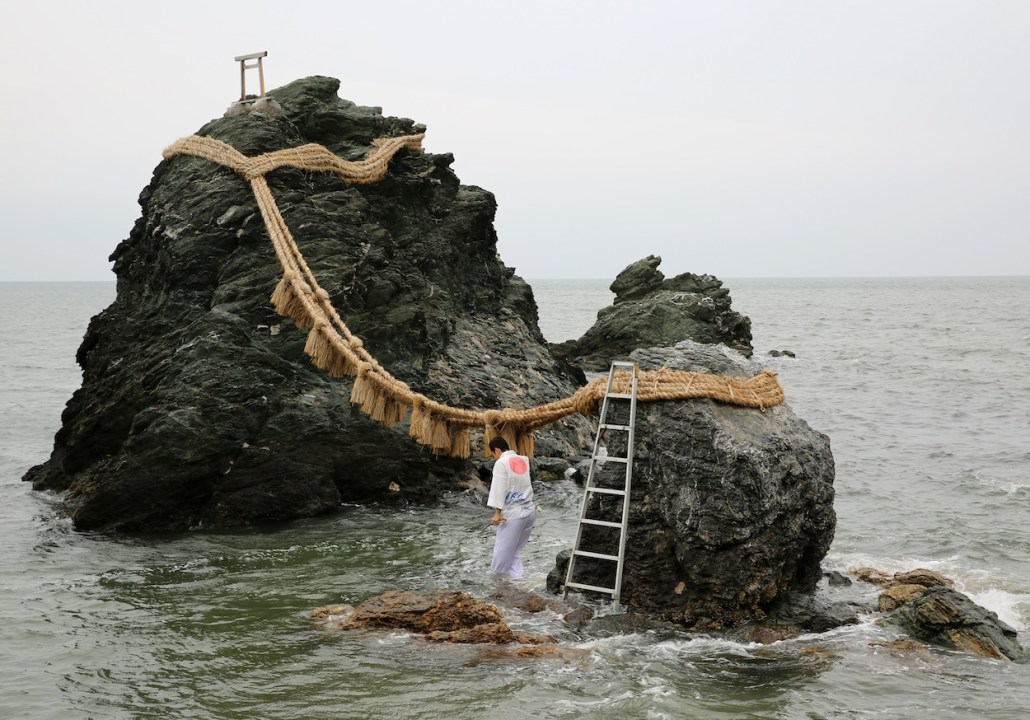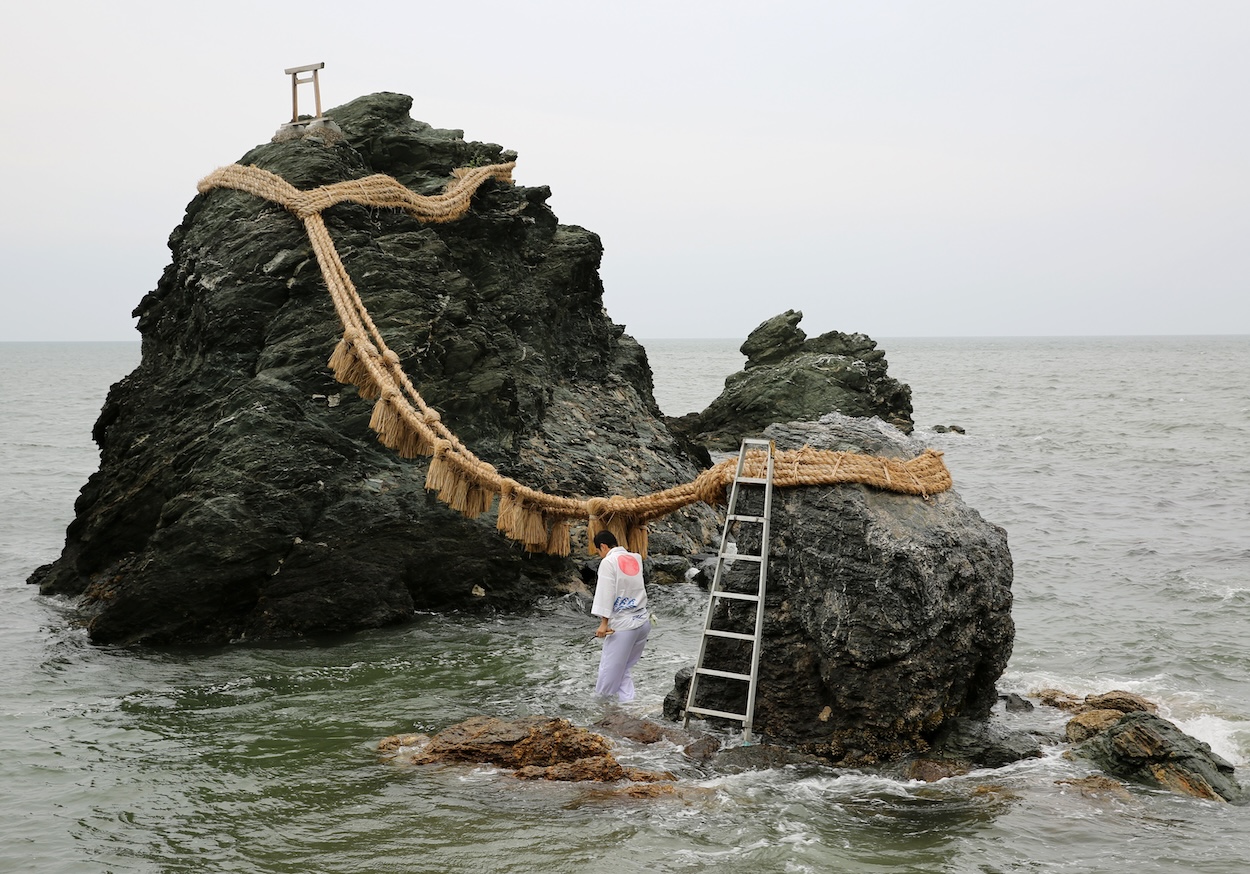Ise, Japan
They say of Japan that if you come here for a week, you want to write a novel about Japan. After a year, maybe a few essays. After a decade, a page. It is one of those countries which seems to get simultaneously more fascinating and opaque.
Possessing an ancient monarchy is like having a Gothic cathedral in your back garden
So it is for me, on this, my first trip to Japan in 30 years (I lived in Kyoto in the mid-1990s). This time around I have been doing prep by reading the early history of Shinto, the ‘state religion’ of Japan, an animist creed which sees the divine in everything – trees, rocks, lakes, rugby balls (really) – all in the form of kami – which can be spirits of place, mood or idea. And what I have learned has, surprisingly, taught me something about modern Britain.
But first, to Japan and its peculiar national ‘faith’. Shinto probably arrived in Japan with the first East Asian settlers of the archipelago, the Jomon people, in 12,000 BC. That makes it bewilderingly ancient, yet it pervades Japanese life and culture to this day: e.g. Shinto is ‘focused’ on the dichotomy of the pure and the impure: that which is dirty must never defile that which is deemed clean, or the universe will be unbalanced. So, if you think the Japanese are obsessed with hygiene and purity, with their white-gloved taxi drivers and their individually wrapped bananas, you’re right, and that’s Shinto at work.
Another way Shinto entwines with life in Japan is its relationship with the Japanese imperial dynasty. In legend – and until the Americans occupied in 1945, in constitutional legality – it was and is accepted that the Japanese Emperor descends directly from the Shinto sun-goddess Amaterasu.
Given that this inception happened in the mists of unreal time, the exact chronology is uncertain. It’s irresistible to romantics. What we do know is that around 700 BC the fabled first emperor Jimmu emerged as allegedly a ‘great-great grandson’ of Amaterasu.
By the 6th or 7th century AD the idea that the imperial family has divine origins was so embedded in royal life that emperors started marrying their close relatives, to keep that godly bloodline untainted. This might explain the crazy Emperor Yozei (9th century AD), who liked to strangle concubines with ‘the strings of musical instruments’.
Having read all this wonderful Shinto history, it was, then, with great anticipation that, once I reached Japan, I aimed for Ise Shrine, quite near Osaka. Because Ise Shrine is the centre of Shintoism. Built around the 4th century, in cooling green forests, the shrine has multiple buildings, but the most important is dedicated to Amaterasu. Members of the imperial family are closely involved with the workings of this Inner Shrine. Indeed members of the family have official roles in the precincts.
I know this, because I saw it. Even as I approached the inner shrine, the police began waving the tourists to the side. And then I saw why: coming towards me was a Shinto procession, of exotically white-garbed priests, led by the imperial princess Kuroda Sayako, the sister of Emperor Naruhito – and appointed shamaness-priestess of Ise.
The Imperial shamaness was parading from the shrine where she had just done the sacred, full moon, mid-October harvest festival rice-offering to the ‘holy mirror of Amaterasu’: the most important ceremony of the year. It was a one-in-a-million chance that I’d encountered her so closely at Ise. I can report that she is the spit of Emperor Hirohito, her grandfather.
Duly excited by all this, I retired to the nearby street of pilgrims for steamed oysters and Asahi beer. And there I got thinking about my own country and the strange similarities between Japan and Britain, these two rainy archipelagos at either end of Eurasia.
On a trivial level, both like tea, rugby, ceremony, queueing. Both, importantly, have been imperial powers, albeit Britain on a much grander scale. Both are always fighting off the gravitational pull of their bigger continental neighbours even as they are profoundly influenced by them (for example, the reason the Japanese traditionally sit on the floor is because that was originally the fashion in magnificent Tang China; the Chinese soon moved on to chairs, the Japanese did not). Both nations have impressive soft cultural power out of proportion to their size.
And, of course, both have very ancient monarchies, their origins lost in religious myth (the King of England is supposedly descended from the Norse God Odin). Both monarchies are entwined with ‘state’ religions – in our case Anglicanism. Both of these monarchies, and all that goes with them, are a constitutional means of binding their nations together in shared and invented memory: something even more necessary now, as both nations face grave problems. These monarchies will, one hopes, help their nations endure.
And yet there is also one profound difference between Japan and the UK. In Japan they largely revere their past, and they accept the good fortune of having an honoured, ancient and panoplied monarchy. It may seem anachronistic, even bizarre, yet the pomp and ceremony of an ancient monarchy is also beautiful, embodying national myths in music, words, art, symbols, people. Possessing an ancient monarchy is like having a Gothic cathedral in your back garden. You wouldn’t build it now, indeed you couldn’t, but my God you’re lucky to have it, and you certainly don’t knock it down.
But of course those on the British left would love to knock ours down, because they either don’t understand the worth of it, or they do understand the worth of it – its embodiment of Britishness – and that makes them angry, envious, and bitter. Around the same time I visited Ise, I spied this illiterate tweet from a British MP, Blair McDougall, about the abolition of the hereditary peers in the House of Lords, which this week is taking full legal effect: ‘You probably never noticed, but earlier this week we voted in Parliment [sic] to end the hereditary principle in our legislature. A line going back to the Witan a millennia ago [sic] has been broken.’
Now, ignoring the fact that it is only the House of Commons that has voted in favour, not yet the Lords, so it isn’t right to say this has been voted for by parliament, or that it is necessarily going to happen. And ignore, too, that there are good arguments for ending the role of hereditary peers in our politics, I am not disputing that. What riles me is the tone of this tweet: ‘a line going back to the Witan a millennia ago has been broken’. This man is illiterately exulting at the wanton, casual destruction of a marvellously ancient thing. These are the words of an imbecile, or a vandal, or both.
We must prepare for more of this. We have unfortunately elected a bunch of insolent, ignorant kids – in the form of the Labour party – to become a government. We now have to endure five years of them scrawling the walls with crayon or giving Chagos to the Chinese. We can only pray that after these five long years they will be brutally dispatched. Perhaps to Yomi, the gloomy and morbid underworld of the Jomon. Whence there is no return.








Comments